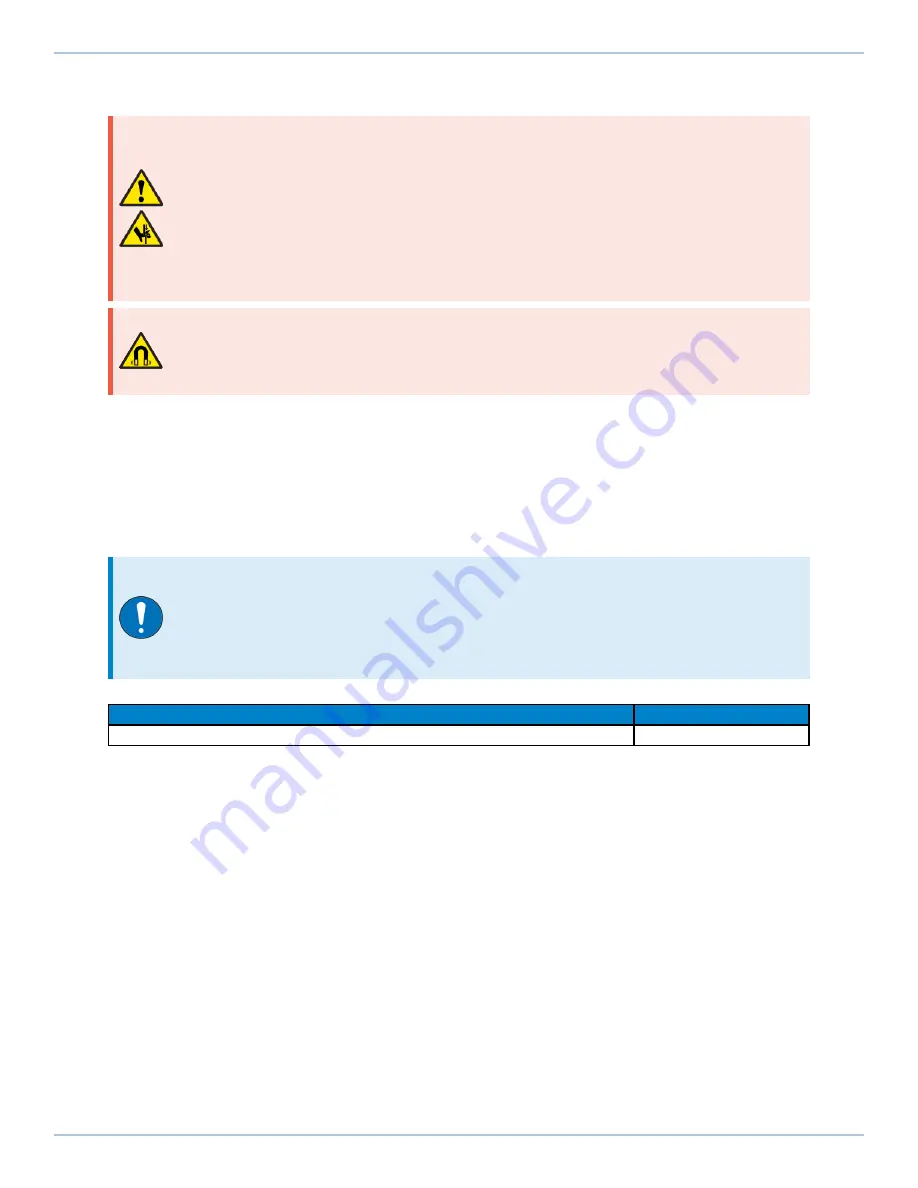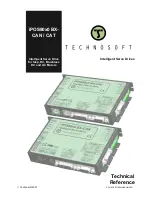
2.2. Securing the Stage to the Mounting Surface
DANGER: Mechanical Hazard!
Personnel must be made aware of the mechanical hazards during set up or when you
do service to the stage.
l
Do not manually move the stage if it is connected to a power source.
l
The stage must be mounted securely. Improper mounting can result in injury and
damage to the equipment.
l
When you move the tabletop manually to do maintenance, this could expose the
operator to internal pinch points. Refer to
on
DANGER
:
Magnetic Field Hazard!
When you move the tabletop manually to do
maintenance, this could expose the operator to the magnet track. Refer to
on
The mounting surface must be flat and have adequate stiffness to achieve the maximum
performance from the stage. When it is mounted to a non-flat surface, the stage can be distorted
while the mounting screws are tightened. This distortion will decrease overall accuracy. Adjustments
to the mounting surface must be done before the stage is secured.
Inspect the mounting surface for dirt or unwanted residue and clean if necessary. Use precision
flatstones on the mounting surface to remove any burrs or high spots. Clean the mounting surface
with a lint-free cloth and acetone or isopropyl alcohol and allow the cleaning solvent to completely
dry. Gently place the stage on the mounting surface.
IMPORTANT
: The stage is precision machined and verified for flatness prior to product
assembly at the factory. If machining is required to achieve the desired flatness, it
should be performed on the mounting surface rather than the stage. Shimming should
be avoided if possible. If shimming is required, it should be minimized to retain
maximum rigidity of the system.
Table 2-1:
Stage Mounting Surface Flatness Requirement
Stage Travel
Flatness Requirement
All Travels
1 µm per 50 mm
1. Remove the shipping brackets mounted to the sides of the stage with M3 screws. Retain the
shipping brackets for future use.
2. With the stage laying horizontal, push the carriage to the bottom of travel such that the cylinder
rods are mostly hidden in the cylinder bodies as shown in
. Insert one M6 socket head
cap screw through an access hole in the stage (refer to
).
3. Two Person Step: Slowly lift the stage upright, using the cylinder mounting brackets as a lifting
point. Be careful to not dislodge the loose screw that you inserted in the mounting hole in Step 2.
Do not lift the stage by the cylinders, carriage assembly, or cabling.
4. Two Person Step: Lift the stage to the mounting surface and line the stage up with the mounting
holes. Use a wrench to engage the previously inserted mounting screw. Make sure the screw is
fully engaged in the threaded hole, but do not tighten it at this time. Rotate the stage to align the
second hole, insert another screw, and thread it in without fully tightening. The screw heads
should be recessed in the counter-bored holes.
5. Two Person Step: Lift the carriage by hand, and hold it up to expose the bottom mounting holes.
Insert the remaining mounting screws. Align the stage per your application, and then tighten the
mounting screws. Refer to
for screw torque specifications.
2.2. Securing the Stage to the Mounting Surface
ANT95LZS Hardware Manual
22
www.aerotech.com
Содержание ANT95LZS Series
Страница 6: ...This page intentionally left blank List of Tables ANT95LZS Hardware Manual 6 www aerotech com...
Страница 16: ...This page intentionally left blank Handling and Storage ANT95LZS Hardware Manual 16 www aerotech com...
Страница 38: ...This page intentionally left blank 3 5 Motor and Feedback Phasing ANT95LZS Hardware Manual 38 www aerotech com...
Страница 46: ...This page intentionally left blank Appendix B Revision History ANT95LZS Hardware Manual 46 www aerotech com...
















































